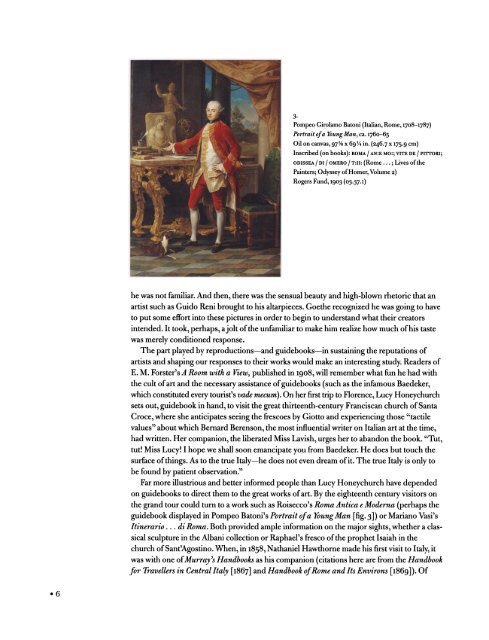GOING FOR BAROQUE Into the Bin - The Metropolitan Museum of Art
GOING FOR BAROQUE Into the Bin - The Metropolitan Museum of Art
GOING FOR BAROQUE Into the Bin - The Metropolitan Museum of Art
You also want an ePaper? Increase the reach of your titles
YUMPU automatically turns print PDFs into web optimized ePapers that Google loves.
3.<br />
Pompeo<br />
Portrait<br />
Girolamo Batoni<br />
(Italian, Rome, 1708-1787)<br />
<strong>of</strong> a Young Man, ca. 1760-65<br />
Oil on canvas, 97%<br />
x 69 Va in. x (246.7 175.9 cm)<br />
Inscribed<br />
(on books):<br />
roma<br />
/ an:e mo:; vite de<br />
/ pittori;<br />
odissea<br />
/ di / omero / T:ii: ...<br />
(Rome ; Lives <strong>of</strong> <strong>the</strong><br />
Painters; Odyssey<br />
<strong>of</strong> Homer, Volume<br />
2)<br />
Rogers Fund, 1903 (03.37.1)<br />
he was not familiar. And <strong>the</strong>n, <strong>the</strong>re was <strong>the</strong> sensual<br />
beauty<br />
and high-blown<br />
rhetoric that an<br />
artist such as Guido Reni<br />
brought<br />
to his<br />
altarpieces.<br />
Goe<strong>the</strong><br />
recognized<br />
he was<br />
going<br />
to have<br />
to put<br />
some effort into <strong>the</strong>se pictures<br />
in order to to begin<br />
understand what <strong>the</strong>ir creators<br />
intended. It took, perhaps,<br />
a jolt <strong>of</strong> <strong>the</strong> unfamiliar to make him realize how much <strong>of</strong> his taste<br />
was merely<br />
conditioned response.<br />
<strong>The</strong> part played by reproductions?and guidebooks?in sustaining<br />
<strong>the</strong> reputations<br />
<strong>of</strong><br />
artists and<br />
our<br />
shaping responses to <strong>the</strong>ir works would make an interesting study.<br />
Readers <strong>of</strong><br />
E. M. Forster's A Room with a View, published<br />
in 1908, will remember what fun he had with<br />
<strong>the</strong> cult <strong>of</strong> art and <strong>the</strong> necessary assistance <strong>of</strong> guidebooks (such<br />
as <strong>the</strong> infamous Baedeker,<br />
which constituted every tourist's vade mecum).<br />
On her first trip<br />
to Florence, Lucy Honeychurch<br />
sets out, guidebook<br />
in hand, to visit <strong>the</strong> great thirteenth-century<br />
Franciscan church <strong>of</strong> Santa<br />
Croce, where she anticipates seeing<br />
<strong>the</strong> frescoes<br />
by Giotto and experiencing<br />
those "tactile<br />
values" about which Bernard Berenson, <strong>the</strong> most influential writer on Italian art at <strong>the</strong> time,<br />
had written. Her<br />
companion,<br />
<strong>the</strong> liberated Miss Lavish, urges her to abandon <strong>the</strong> book. "Tut,<br />
tut! Miss<br />
Lucy!<br />
I hope<br />
we shall soon<br />
emancipate you from Baedeker. He does but touch <strong>the</strong><br />
surface <strong>of</strong> things.<br />
As to <strong>the</strong> true Italy?he<br />
does not even dream <strong>of</strong> it. <strong>The</strong> true Italy<br />
is only<br />
to<br />
be found<br />
by patient<br />
observation."<br />
Far more illustrious and better informed<br />
people<br />
than Lucy Honeychurch<br />
have<br />
depended<br />
on guidebooks<br />
to direct <strong>the</strong>m to <strong>the</strong> great works <strong>of</strong> art. By<br />
<strong>the</strong> eighteenth century visitors on<br />
<strong>the</strong> grand<br />
tour could turn to a work such as Roisecco's Roma Antica e Moderna<br />
(perhaps<br />
<strong>the</strong><br />
guidebook displayed<br />
in Pompeo<br />
Batoni's Portrait<br />
<strong>of</strong> a Young Man or<br />
[fig. 3])<br />
Mariano Vasi's<br />
Itinerario... di Roma. Both<br />
provided ample information on <strong>the</strong> major sights,<br />
whe<strong>the</strong>r a clas<br />
sical<br />
sculpture<br />
in <strong>the</strong> Albani collection or Raphael's<br />
fresco <strong>of</strong> <strong>the</strong> prophet Isaiah in <strong>the</strong><br />
church <strong>of</strong> Sant'Agostino. When, in 1858, Nathaniel Hawthorne made his first visit to Italy,<br />
it<br />
was with one <strong>of</strong> Murray's<br />
Handbooks as his companion (citations<br />
here are from <strong>the</strong> Handbook<br />
for Travellers in Central Italy [1867] and Handbook <strong>of</strong> Rome audits Environs [1869]). Of<br />
6
















